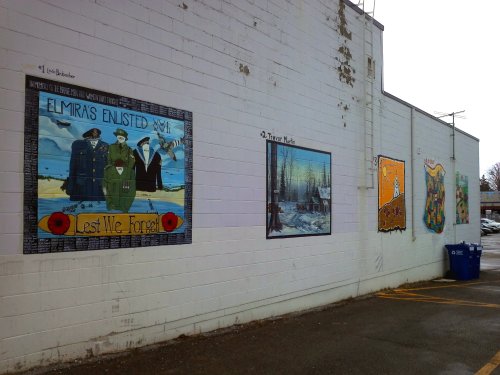Although art competitions ostensibly exist to benefit the artists, the contest holder is always the chief beneficiary, as shown by a local hardware store’s mural contest a few years back.
Murals
The Victor Clothing Company’s Anthony Quinn mural in Los Angeles was quite impressive when I saw it years ago. Since then, murals have come into vogue in Southern Ontario.

Creating a mural is not easy, nor cheap, and requires maintenance. Currently the the stunning mural created by Eloy Torrez in Los Angeles is in serious need of restoration after 27 years.
Murals Come to Elmira
A competition was announced: five local artists were selected to design and create their own original 6′ x 6′ murals on the blank wall facing the Elmira Home Hardware Store parking lot.
1. Linda Brubacher
2. Trevor Martin
3. Pat Lackenbauer
4. Jo Oxley
5. Paul Wilson
The way the contest worked, interested folks could vote for their favourites, but voters had to pay for their ballot. In this way, the Home Hardware campaign “raised about $2,500”.
California’s Victor Clothing Company commissioned artists to create the now famous murals.
In comparison, Home Hardware got a wall full of free murals, a reputation both for “supporting local artists” and for providing the community with public art, a charitable donation, and all the accompanying publicity.
The community got some nice public art which remains in reasonably good condition almost seven years later.
And the artists?
They had to undergo a selection process, then conceive an idea, plan out the design, and then actually paint the thing.
Trevor Martin’s winning mural paid him $500; not a terrible return for work he estimates took about 24 hours.
The other four artists each received $100. If it took them each ten hours to paint their murals, they may just about have managed to earn minimum wage. My guess is that each mural took well over ten hours to paint, so except for the winner, none of the artists are likely to have even earned minimum wage.
Pretty good deal, right?
The rest of the money raised was donated to charity.
An argument is usually made that the artists get exposure from a contest like this. In some cases it can be valuable, but artists still need to eat. Plumbers need exposure, too, yet I can’t recall anyone suggesting that they should donate their work for it. Perhaps in future supporting local artists might mean paying them a reasonable amount for their work.
But even if exposure is an important consideration, is a contest like this one the right kind of exposure? Particularly when there is a “winner”, well, we all know what the word for a non-winner is. Does that kind of exposure really help an artist’s career? And who are the judges?
online
These days you can find all manner of art “contests” online. The artist is generally required to herd their family, friends and fans to the contest venue to get them to vote. Most of the ones I’ve seen don’t require a simple voting, but repetitive voting over time. And before people can vote, they have to register, and give up a lot of personal information. (Guess where SPAM comes from…) So again, the voters pay the price. Do you really want to do this to your fan base?
So I have yet to wonder about any net benefit to the artist. Although a contest dangles a prize, is that prize worth the price you have to pay for it?
know what you’re getting into
Before even creating a contest entry, let alone posting your work, always read the contest rules. Any contest submission will necessarily transfer or sharing at least some of the artist’s rights to their own work to the contest holder. [As does posting your work to any website that you yourself don’t control.] Be very sure that you know what you are agreeing to. And that you can live with it. For artists, the main advantage to the proliferation of art contests is that there is always another contest.
Because, after all, the main beneficiary of any contest is always the contest holder. After all, they get to make the rules.





